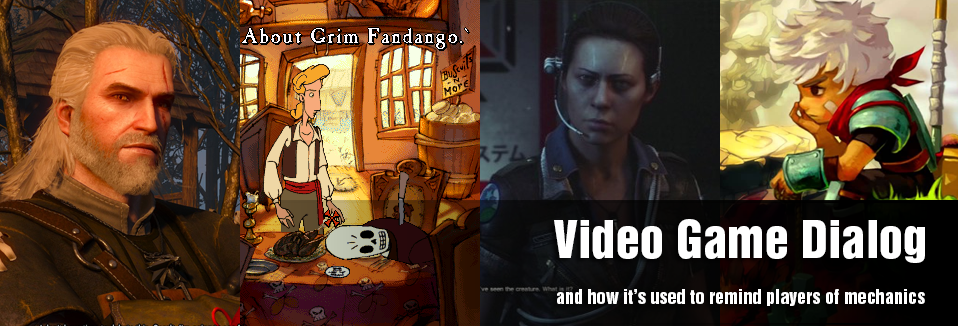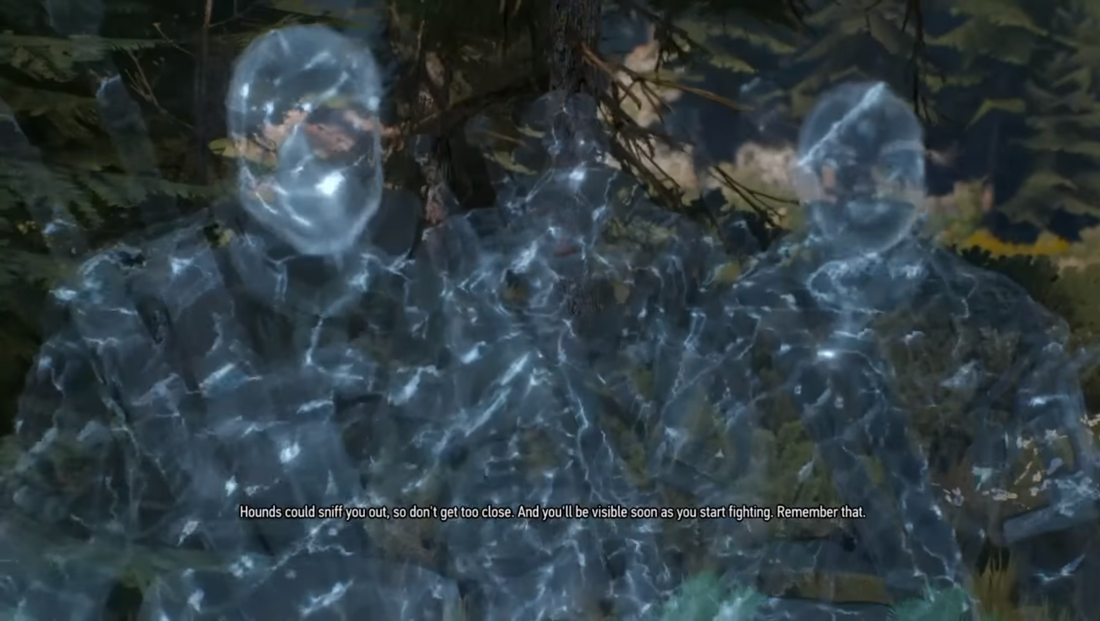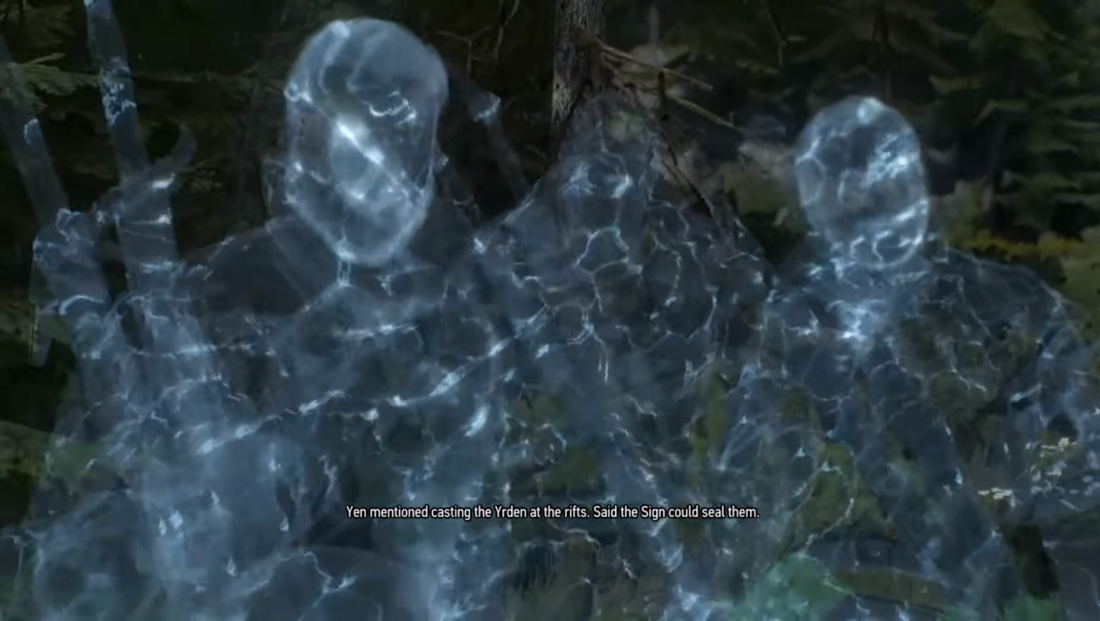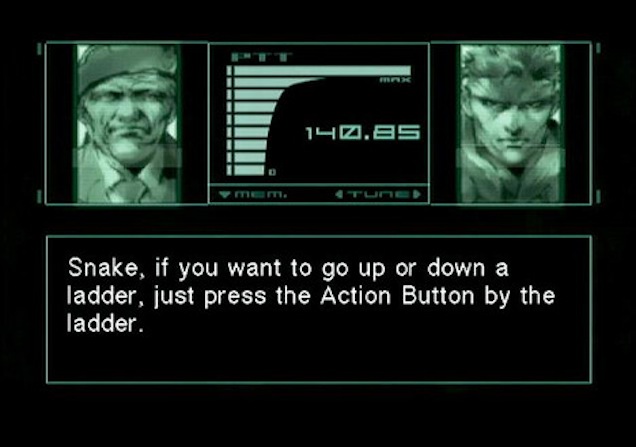|
|
Personal Projects
|
|
|
How are Video Games using dialog to reinforce the player’s understanding of the game mechanics? It’s not something I’ve often thought about, but most modern games use dialog to facilitate the player’s understanding to some extent. More often than not, games are using dialog to explain quest objectives, give hints to the player, or remind players of game mechanics. In today’s blog post I’m going to be exploring this a bit, and showing some different dialog examples that I’ve found interesting. I’ll be showing examples from Alien Isolation, Bastion, The Curse of Monkey Island, and The Witcher 3, and so if you’re concerned about potential spoilers for any of these titles… you may want to turn back. I’d like to start with the game that got me thinking about this topic, The Witcher 3. I know this game came out in May of last year, but I only returned to it just recently. While on a couple of missions I started to recognize that within the playful banter between characters, they were actually discussing game mechanics. Yet they were discussing them in ways that didn’t fully remove me from the play experience. What was important was that, contextually, the reminders all made sense in the situation. Little things like a character reminding me that there are more bombs in barrels near the wall, as enemies flooded the front gate of the fortress we were protecting. What the Witcher 3 does extremely well is that they are able to introduce new game mechanics, and typically it’s only for one mission. It’s interesting to change up the game play a bit (even past 30 hours into a game), where it forces the player to modify their play style. The best example I can think of within the Witcher 3 is the mission “Battle of Kaer Morhen.” The premise of this mission is that you’re trying to essentially protect your base from an attacking army. Right away new mechanics are introduced to the player, Geralt (the protagonist) is given an item where he and his comrades are invisible and is tasked with using guerrilla tactics in the forest near the castle. The enemy army is using portals and so you have to use your “bombs” to close the portals, and your invisibility to take them by surprise. This is all explained to the player right away, and then later right as the mission starts there’s some banter between Geralt and an NPC where he’s reminding the NPC (and really the player) : “Hounds could sniff you out, so don’t get too close. And you’ll be visible as soon as you start fighting, remember that.” Out of context, it’s super obvious what they are doing here with this dialog, but within the cutscene I found that it worked. Within the same cut scene, they also provide more useful information for the players : “Yen mentioned casting Yrden at the rifts, Said the sign could seal them.” Yrden is one of the spells that the player has in their arsenal, and again another good reminder for the player of what to do in the mission if they run out of bombs. This is really what kicked off my curiosity about how often games are using dialog in these ways. I started to think back on previous games to try to remember other examples of dialog. I think one of the most iconic examples I can remember is “Use the Boost to get through” from the original Starfox 64. I was looking for a youtube link to include in this post and stumbled upon a video that shows every word that “Peppy” says from Starfox, and it’s literally riddled with player information. Unfortunately we probably only recognize dialog like this, when it's done poorly and it becomes obvious. While searching for bad examples of dialog, it was hard to differentiate ones that have become meme worthy, because they are used too often in video games, and those that are poorly written instructional dialog. I think we all recognize ones like “I can smell
Alien Isolation uses dialog quite heavily to explain puzzles and quest objectives to the player. While playing the game I remember my character was often receiving instructions from other characters. At times it’s mechanics based but upon further investigation I found that much of the dialog was meant to aid the player in understanding where to go, and what they should be doing. Sometimes it’s little things like “...you should take that flashlight…” and additional dialog that tells you that if you wave the light around, enemies will notice. This is important game information explained to the player in the appropriate context. I had a hard time finding imagery for this, yet I have a lot of memories of Samuels (another character in the game) providing me with information on how to complete puzzles, and what to do next. Alien Isolation is all about player immersion and expertly uses dialog to keep the player in the world, and still provide them with all the gaming knowledge they’ll need.
clues to game mechanics as well. When the player finds a bow the narrator adds “He knows he should draw the string all the way back,” essentially informing the player that they need to press and hold the attack button before releasing. This was a really fun strategy for narration, providing player context into the world, and a stylized way of keeping them immersed while they do it. Looking back to The Curse of Monkey Island, I really thought that I would find more literal examples of instructional dialog… similar to Peppy in Starfox 64. Instead I found that the dialog used was more about providing hints and possible direction for the player. Things like “I’m too low,” allows the player to infer that maybe they need to be higher… or “He’s not going for the flower just by itself,” so maybe I need to combine the flower with something else. I really appreciated going back through these kinds of dialog, often in modern gaming we are too afraid of having elements be cryptic to our users… so we don’t trust them and provide an abundance of information. While in The Curse of Monkey Island, they are trusting their players to think things through.
While I’d like to be able to provide more analysis on specific strategies used for dialog, and how to appropriately illustrate game mechanics, it’s really not my field and I wouldn’t know where to start. In any case I hope that this look into how games use dialog in different ways to aid players was interesting. I’m sure that there are many more examples out there, and that while playing we can take a moment to recognize when dialog is done really well… and maybe chuckle when it’s not.
0 Comments
|
AuthorI make games, I play games... and sometimes I have some thoughts about that. Archives
March 2024
|
Proudly powered by Weebly

















 RSS Feed
RSS Feed